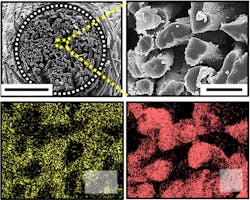A glucose-powered biofuel cell developed by researchers at the Georgia Institute of Technology and Korea University uses electrodes made from cotton fiber, and could someday power implanted medical devices such as pacemakers and sensors. The new fuel cell, which provides twice as much power as conventional biofuel cells, could be paired with batteries or supercapacitors to provide a hybrid power source for the medical devices.
The cathodes have gold nanoparticles assembled on the cotton that create high-conductivity electrodes that improve the fuel cell’s efficiency. That lets researchers address one of the major challenges limiting biofuel cells performance: connecting the enzyme used to oxidize glucose with an electrode.
A layer-by-layer assembly technique fabricates the gold electrodes and raised the power capacity to as much as 3.7 milliwatts per square centimeter for the electrocatalytic cathode and the conductive substrate for the anode. “We could use this device as a continuous power source for converting chemical energy from glucose in the body to electrical energy,” says Seung Woo Lee, an assistant professor at Georgia Tech.
Fabrication of the electrodes begins with porous cotton fiber composed of hydrophilic microfibrils—i.e., cellulose fibers containing hydroxyl groups. Gold nanoparticles about eight nanometers in diameter are affixed to the fibers using organic linking materials.
Scanning electron microscope images show details of the cotton-based electrodes used in a new biofuel cell. (Credit: Georgia Tech/Korea University)
To create the anode for oxidizing the glucose, the researchers apply glucose oxidase enzyme in layers alternating with an amine-functionalized small molecule known as TREN. The cathode, where the oxygen reduction reaction takes place, uses the gold-covered electrodes, which have electrocatalytic capabilities.
“We precisely control enzyme loading,” Lee says. “We made a thin layer so that charge moves more easily between the conductive substrate and enzyme.”
The cotton’s porosity handles more gold layers compared than a nylon fiber. “Cotton has many pores that support activity in electrochemical devices,” explains Yongmin Ko, a team researcher. “Cotton fiber is hydrophilic, so the electrolyte easily wets the surface.”
Beyond improving the electrodes’ conductivity, the cotton fiber could improve the device’s biocompatibility, which is designed to operate at low temperatures inside the human body.
Implantable biofuel cells degrade over time, and the new cell developed by the U.S. and Korean team offers improved long-term stability.
Pacemakers and other implants are powered by batteries that last years, but may still require replacement in a surgical procedure that requires surgery. The biofuel cell could provide a continuous charge for those batteries, potentially extending how long devices operates without battery replacement.
In addition, the biofuel cell could power devices intended for temporary use. These devices might be implanted to provide timed drug release, but would biodegrade rather than require surgical removal. For these applications, there would be no battery and any limited power could be provided by the biofuel cell.
Future goals of the research include operating the biofuel cell with an energy storage device and developing an implantable power source. “We want to develop other biological applications for this,” said Lee. “We’d like to go farther with other applications, including batteries and high-performance storage.”


